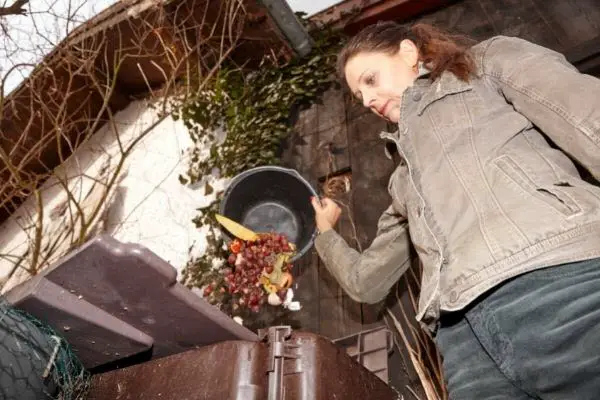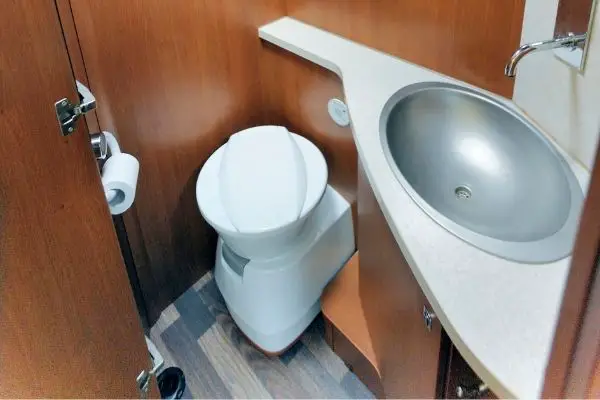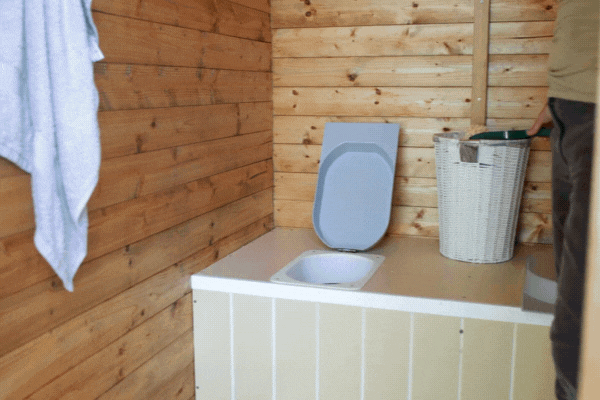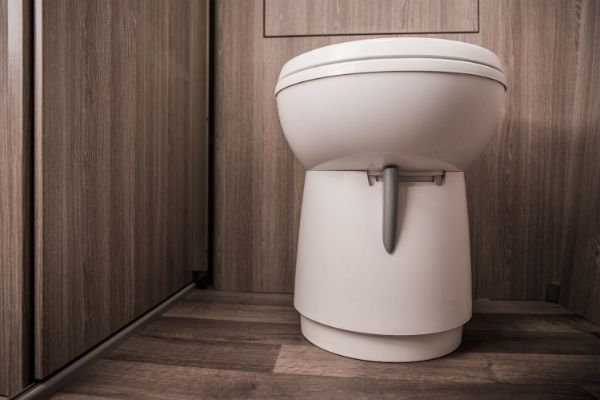Composting Toilets Pros And Cons – Practical or Not?
In my quest for living a more sustainable life, I often come across people who could not be bothered.
Until not long ago, such an attitude shocked and surprised me. But I think I get it. Changing habits can be hard. Similarly, doing things in a way that requires extra work is hard when we all lead incredibly busy lives.

Take composting food scraps versus throwing it all in the trash – of course, composting requires more effort. There’s also more reward, but you need to be willing to do the work!
If given the chance, few people would say no to a more environmentally conscious life. The reason so many people don’t is that switching to a more sustainable lifestyle often comes with a few (albeit minor) drawbacks.
On the other hand, no home fixture is perfect — including the flushing toilet. But it’s easy to overlook the downsides of a standard toilet when it’s what we’ve used our entire lives.
Knowing the pros and cons of composting toilets is the only way to decide whether or not these fixtures are the ideal choice for your family. You never know… you might discover that a composting toilet is actually more convenient, economical, or affordable than your current bathroom setup!
So before running out and investing in an eco-friendly composting toilet of your own, here’s everything you need to know about these innovative bathroom fixtures:

What is a Composting Toilet?
Put simply, a composting toilet is an eco-friendly system that collects human waste and allows it to safely decompose into a dry, sanitary, and nearly odorless material called humus.
Composting toilets are often installed in RVs and boats but can also be used inside in place of flushable toilets in any home.
Benefits of Composting Toilets
Minimal Water Consumption
By far, the greatest benefit for both you and the planet is that composting toilets require little (if any) water. Since flushing toilets are responsible for up to 30% of the average household’s water consumption, this simple change could have a big impact on your monthly utility bill.
Of course, the most important side effect of consuming less water is the lessened toll on Earth and its resources. And since you’re not using water in the first place, there’s no need for the electricity or harmful chemicals involved in treating wastewater after you flush.
Long-Term Affordability
Between lack of routine repairs, no water bill, and zero plumbing costs, the grand total for installing and operating a composting toilet is typically significantly less than a traditional one. The longer you use your composting toilet, the more the savings will add up.
Easy To Use
Yes, switching to a composting toilet can be daunting for anyone used to a simple flush. But once you understand the inner workings of your new waste system, maintaining it will be just another part of your household routine.
As long as you remember to empty the finishing chamber on a regular basis, your new composting toilet will need very little attention overall.

Space-Efficient
The average composting toilet is a wonderful option for any small bathroom. This is because the bulk of the system is contained underneath the bathroom floor (often in space that would otherwise sit empty). The user-facing part of the toilet is much more compact than traditional models!
Create Usable Fertilizer
Compost created by one of these toilet systems is hardly any different than the fertilizer you make from kitchen scraps and grass clippings. It can be applied to your lawn or ornamental garden for strong, healthy plants without the need for commercial chemicals.
No Need for a Septic System
A septic system can be expensive to install and, at best, annoying to maintain. And that’s not even mentioning the potential for back-ups or other issues that can be both gross and costly.
While there is a time and place for a septic system, a composting toilet completely eliminates the need for one in the first place. So there’s no need to tear up your yard. (Or, in the case of an RV or towable tiny home, commit to a single location!)
Appropriate for Non-Traditional Homes
Speaking of RVs and other non-traditional living spaces, compostable toilets are one of the best solutions for those looking for the convenience of a regular toilet without any of the plumbing.
And if you spend a lot of time sailing, then a compostable toilet may be the only feasible option.
Living on the road (or the water) is a wonderful opportunity for many. But there’s no shame in wanting to avoid “roughing it” when it comes to your household bathroom habits!
Simple Construction
Even expertly installed plumbing can spring a leak every now and again. Composting toilets contain very few moving parts, meaning they are far less likely to experience issues throughout their lifespans.
If you’re a self-proclaimed DIYer, many routine composting toilet issues can be solved with a little elbow grease and the right tools.
Disadvantages of Composting Toilets

Initial Cost
Installing and maintaining a composting toilet may be cheaper than the alternatives. Unfortunately, that doesn’t mean that purchasing the toilet system itself is cheap. Composting toilets are notably more expensive than traditional flushable toilets.
Regular Maintenance
Will you need to worry about your composting toilet springing a leak or succumbing to a clog? Probably not. But composting toilets do require regular emptying to continue holding and breaking down waste.
Each composting toilet is capable of holding a certain amount of waste and finished compost. The more people who use the toilet, the more frequently finished compost must be removed from the lower compartment.
Forgetting or neglecting to empty your composting toilet could disrupt the enzymes and bacteria within. It could also result in foul odors emanating from the holding compartments.
Require Electricity
Although composting toilets operate without water, they do require electricity. Without electricity, the fan and other powered parts beneath the toilet bowl will not work.
For those living off-the-grid, there’s good news. Most composting toilets require a low amount of electricity, which can be supplied using a generator or alternative energy source (like solar panels) if needed.
There are also a select few composting toilets that do not use electricity. These models may take longer to break down waste and are more likely to produce unwanted odors.
Won’t Fit Everywhere
When it comes to selecting and installing a flushing toilet, there’s little you need to worry about except the porcelain structure itself. Yet installing a composting toilet also means ensuring there is enough space below your bathroom floor to accommodate the lower compartments. Not all homes will have a floor plan that can fit a standard composting toilet.
Ick Factor
No matter how practical you think you are, it can be hard to get over the idea of handling composted human waste. You may even find that some guests are grossed out by the fact you own a composting toilet.
Odor Potential
Ideally, a composting toilet should never smell bad. Of course, that doesn’t mean the potential isn’t there. A composting toilet that is not functioning properly or is not maintained may produce foul odors.
Limited Design Options
Those with a discerning eye for interior design might be disappointed by the limited composting toilet market. While a lack of design variety is certainly one of the smallest composting toilet drawbacks, it is still something to be aware of.
Not for Vegetable Gardens

In theory, the compost produced by one of these toilet systems is completely sterile. But using the finished compost on edible plants could still spread harmful pathogens. So if you had your hopes set on using a composting toilet to fertilize your vegetable garden, it’s best to rethink that plan!
Frequently Asked Questions
How do you dispose of composting toilet waste?
When it comes to marine and RV composting toilets, the pros and cons are largely the same as an in-home system. However, while routine emptying of the finished compost is a must, disposing of this material can be a bit tricky in some situations.
For example, it is illegal to dispose of finished compost from one of these toilets in many territories of water. Instead, the collected waste must be stored elsewhere until it can be safely disposed of onshore. Even onshore, burying the humus is often required.
Some RV parks and campgrounds may have restrictions about disposing of composting toilet waste on the property at all. One common solution may be to dispose of the compost in a flushing toilet or public garbage. But this negates the environmental benefits associated with opting for a composting toilet system in the first place.
How often should a composting toilet be emptied?
On average, you can expect to empty a residential composting toilet every 1 to 2 months. Unfortunately, there is no answer to this question that applies to all composting toilets.
Many factors determine how often a toilet will need to be emptied, including the number of users, size, and rate of decomposition.
Can you put toilet paper in a composting toilet?
Yes. Since paper is made from plants (in most cases, trees), it is compostable. Toilet paper can be placed in your composting toilet to break down.
Keep in mind that not all toilet paper decomposes at the same rate. Invest in specialty bathroom tissue for use in RVs or boats for the best results.






